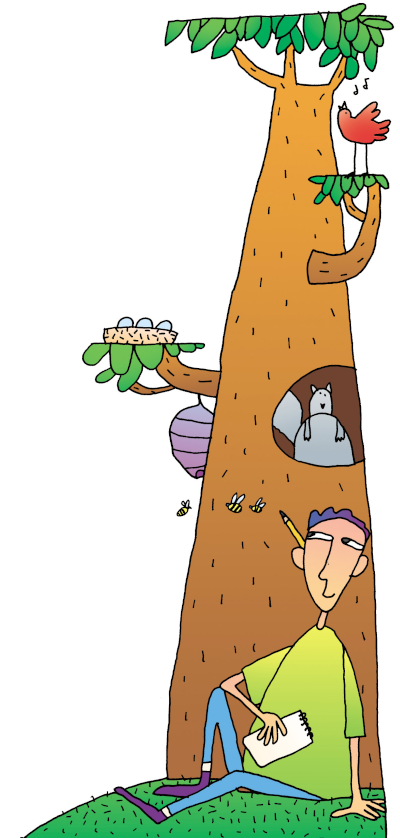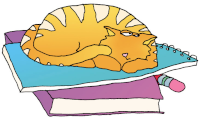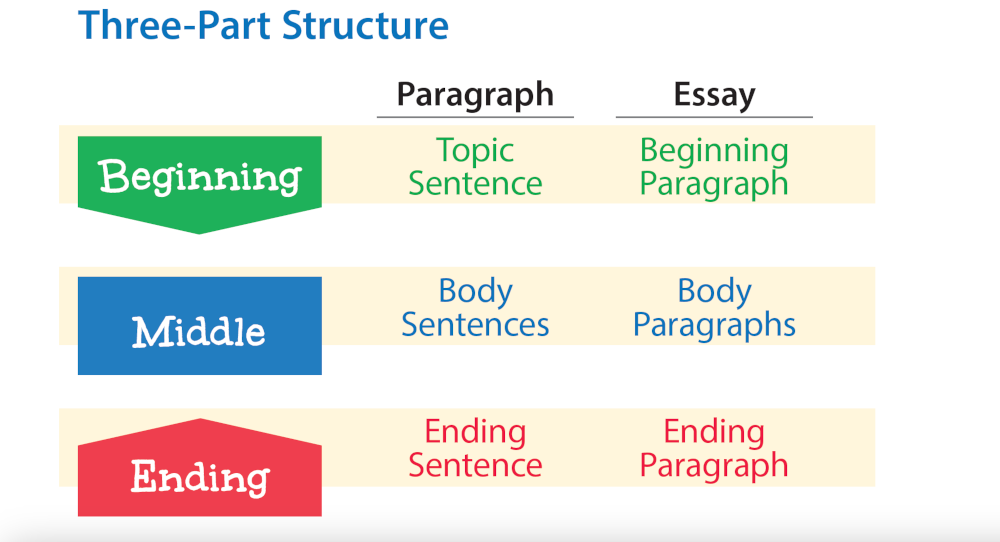
Page 85
Writing Paragraphs
Look at all the homes on this page—homes for birds and bees and squirrels. Even our young writer seems quite at home there beside his favorite tree.
A paragraph provides a home for ideas. The topic sentence is the front door, inviting you inside. The body sentences are the rooms filled with furniture. And the ending sentence is the back door, leading you out to the world.
In this chapter, you’ll read about many types of homes in many types of paragraphs, the homes for ideas.
What’s Ahead
WE 086
Page 86

The Parts of a Paragraph
A paragraph has three main parts. The topic sentence states the main idea. The sentences in the body of the paragraph are all connected to the main idea. The ending sentence sums up the main idea and brings the paragraph to a close.
Sample Paragraph
Topic Sentence Humans build homes, but so do many other creatures. Birds build nests of twigs, and squirrels build nests of leaves. Foxes dig dens underground, as do mice and voles and rabbits. Chimpanzees make leafy hammocks for themselves high in the canopy. Body Sentences Ants build mounds, and termites build bigger mounds, and anteaters and chimpanzees come to these mounds for supper. Humans live in apartments, houses, and mansions, too. Ending Sentence Whether a creature lives high in a tree or deep underground or on floor 3 of an apartment building, homes keep us safe.
WE 087
Page 87
A Closer Look at the Parts
The Topic Sentence
The topic sentence tells the reader what the paragraph is about. A good topic sentence does two things: (1) it names the topic, and (2) it gives the focus or main point.
Formula:
An interesting topic + a specific focus or feeling = a good topic sentence
Topic Sentence:
Humans build homes (an interesting topic) but so do many other creatures (a specific focus).
The Body
The sentences in the body of the paragraph include the specific details that the reader needs to understand the topic. The following sentences include plenty of specific details.
Birds build nests of twigs, and squirrels build nests of leaves. Foxes dig dens underground, as do mice and voles and rabbits. Chimpanzees make leafy hammocks for themselves high in the canopy. Ants build mounds, and termites build bigger mounds . . .
Organize your sentences in the best possible order. Three common ways to organize your sentences include time order, order of location, and order of importance. (See page 94.)
The Ending Sentence
The ending sentence comes at the close of the paragraph and sums up the main point.
Ending Sentence:
Whether a creature lives high in a tree or deep underground or on floor 3 of an apartment building, homes keep us safe.
WE 088
Page 88
Types of Paragraphs
There are four main types of paragraphs.
- To describe something, write a descriptive paragraph.
- To tell a story, write a narrative paragraph.
- To explain something, write an explanatory paragraph.
- To express your opinion, write a persuasive (argument) paragraph.
Sample Descriptive Paragraph
In a descriptive paragraph, you describe a person, a place, a thing, or an idea. When you write a descriptive paragraph, use words related to the five senses. Tell your audience about the sights, sounds, colors, smells, and textures related to the subject. This will help your readers feel as if they are right there with you.
The topic sentence sets the scene. My bedroom may be small, but it’s my favorite place in the world. It’s L-shaped, with a door that opens into that little dog-leg. There’s a drafty window on one side and golden knotty pine on three walls. Dad built the other walls from plasterboard. The details show what you see and feel. I have a Formica desk and a scratched-up dresser and a messy bed, but above it is a mural. I painted it to look like a church window swung open. Beyond is a grassy hill with a tree, and below, a sea growing dark with sunset. A sailing ship flies above the sea. People think it’s weird that the ship is flying, but I don’t. That’s my imagination taking me away. A final thought brings the paragraph to an end. So, in my tiny room, I’m free to sail to anyplace I can dream.
WE 089
Page 89
Sample Narrative Paragraph
In a narrative paragraph, you share a personal experience. You try to pull your readers into the story and keep them wondering what will happen next. Be sure to include specific details to make your experience come to life.
The topic sentence identifies the experience. Last week, Dad wanted to put a new pedestal sink in our bathroom at home, and he asked me to help. He knelt by the old sink, shut off the water, and loosened the supply hoses. I passed him tools. Dad then dismantled the trap, catching the gross water in a bucket. A few bolts later, the sink came away from the wall. We hauled it to the trash. Specific details build suspense. Afterward, Dad let me bolt the new sink in place and showed me how to assemble the new trap. “Don’t tighten it too much, or the pipe will break!” He slid the pedestal in place and turned on the water. Suddenly, we had two geysers spraying all over the bathroom. The supply hoses danced like angry snakes spitting venom. Dad fought his way past them and shut off the valves. We sat there, soaked, with water dripping from the ceiling. The final sentence sums up the story. Dad smiled and said, “Well, this time, let’s remember to connect the hoses to the faucet.”
Note Be sure to include all the important details in your narrative paragraph. Answer the following questions: Who? What? When? Where? Why? How?
WE 090
Page 90
Sample Explanatory Paragraph
Your main purpose in an explanatory paragraph is to give information about a subject. You may give directions, present ideas, or explain how to do something. An explanatory paragraph often uses transition words such as first, then, after, and finally.
The topic sentence identifies the topic. When my grandpa moved into a nursing home, my family had to prep his house for sale. What work! First, Mom and her brother and sister made a list of all the heirloom stuff, and they one by one selected things they wanted. Meanwhile, my brother and I hauled junk to a huge Dumpster. A neighbor took an old air compressor and snow blower from the garage. The details are listed in the order they happened. We also donated furniture to a community theater. Once we got the place cleared out, we still had to rip out the old shag carpet, revealing beautiful hardwood floors. Those would help sell the house. Then we had a painting party in the basement to make it less dingy. Mom pressure washed the outside and hired a man to fix windows. In the end, the house looked better than it had in years. The final sentence brings the explanation to an end. It takes a lot of work to prep a house for sale, but I guess we did a good job. It sold in just one week!
Tip Before you begin writing, it’s helpful to list the facts or examples you are going to include in your paragraph. That way, you can put your supporting ideas into the best possible order before you begin.
The topic sentence identifies the topic. When my grandpa moved into a nursing home, my family had to prep his house for sale. What work! First, Mom and her brother and sister made a list of all the heirloom stuff, and they one by one selected things they wanted. Meanwhile, my brother and I hauled junk to a huge Dumpster. A neighbor took an old air compressor and snow blower from the garage. The details are listed in the order they happened. We also donated furniture to a community theater. Once we got the place cleared out, we still had to rip out the old shag carpet, revealing beautiful hardwood floors. Those would help sell the house. Then we had a painting party in the basement to make it less dingy. Mom pressure washed the outside and hired a man to fix windows. In the end, the house looked better than it had in years. The final sentence brings the explanation to an end. It takes a lot of work to prep a house for sale, but I guess we did a good job. It sold in just one week!
Tip Before you begin writing, it’s helpful to list the facts or examples you are going to include in your paragraph. That way, you can put your supporting ideas into the best possible order before you begin.
WE 091
Page 91
Sample Persuasive Paragraph
In a persuasive or argument paragraph, you give your opinion about a topic and try to prove its value or worth. To do this, you need to provide strong facts and examples that support your opinion. Otherwise, you won’t be convincing.
The topic sentence states an opinion. Dogs and cats at the animal shelter need homes, and homes need dogs and cats. In fact, the CDC says that most households in the United States have at least one pet. Did you know that petting a cat can lower your blood pressure and reduce stress? The body gives reasons. In addition, taking a dog for a walk gives good exercise and fresh air. Pets also help prevent loneliness and depression. Most importantly, pets have fun personalities and do silly things that make us laugh. So, those are things a pet can do for you. Here’s something you can do for them: Go with an adult to the animal shelter and meet some of the pets there. See which ones you like. Ask the workers what their health is like and what their behavior is. In other words, find yourself a friend. The ending restates the opinion. You’ll be happy you did, and your pet will help make your house a home.
Express Yourself
Read your paragraph out loud so that you can listen for missing information. Also turn to page 397 in your handbook for more ideas about using facts and opinions in your writing.
The topic sentence states an opinion. Dogs and cats at the animal shelter need homes, and homes need dogs and cats. In fact, the CDC says that most households in the United States have at least one pet. Did you know that petting a cat can lower your blood pressure and reduce stress? The body gives reasons. In addition, taking a dog for a walk gives good exercise and fresh air. Pets also help prevent loneliness and depression. Most importantly, pets have fun personalities and do silly things that make us laugh. So, those are things a pet can do for you. Here’s something you can do for them: Go with an adult to the animal shelter and meet some of the pets there. See which ones you like. Ask the workers what their health is like and what their behavior is. In other words, find yourself a friend. The ending restates the opinion. You’ll be happy you did, and your pet will help make your house a home.
Express Yourself
Read your paragraph out loud so that you can listen for missing information. Also turn to page 397 in your handbook for more ideas about using facts and opinions in your writing.
WE 092
Page 92
Writing a Paragraph
Prewriting Planning Your Paragraph
As you start a paragraph assignment, ask yourself the PAST questions.
Purpose: Why am I writing—to explain, to describe, to persuade?
Audience: Who will be reading my paragraph?
Subject: Who or what will I write about?
Type: What kind of paragraph will work best?
Subject: Who or what will I write about?
Type: What kind of paragraph will work best?
After you answer these questions, start gathering details.
For a . . . |
you’ll need . . . |
descriptive paragraph |
details that tell how the topic looks, sounds, smells, feels, and tastes. |
narrative paragraph |
details about an experience: how it began, problems that came up, how it ended. |
explanatory paragraph |
details that give information or explain the subject you’re writing about. |
persuasive paragraph |
facts, figures, and examples to back up your opinion. |
Writing Developing a First Draft
Put your information in order. The topic sentence usually comes first. Next comes the body—the sentences that tell about the topic sentence. Your ending sentence should sum up the paragraph or remind the reader what it all means.
Revising and Editing Improving Your Paragraph
Read your paragraph as if you were reading it for the first time. Did you include enough details to support your topic sentence? Do your sentences read smoothly? Did you check for errors?
WE 093
Page 93
Adding Details
To bring your paragraph to life, you need to include facts, examples, and other specific details.
Personal Details
Many of the details you use in your paragraphs will be personal details—things you know from your own experience.
Details from Your Senses 🟪 These are things that you see, hear, smell, taste, and touch. Focus on senses when writing a descriptive paragraph.
Relatives chatter happily around the kitchen island while turkey-scented steam billows from the open oven door.
Details from Your Memory 🟪 These details come from memories of things you’ve done and experienced. In descriptive and narrative writing, such details can bring the past to life. In an explanatory paragraph, they can help you explain how to do something.
Then we had a painting party in the basement to make it less dingy.
Details from Your Imagination 🟪 These details are things you hope for, wish for, and wonder about. Such details can make narrative paragraphs interesting and fun.
The supply hoses danced like angry snakes spitting venom.
Details from Other Sources 🟪 When you write a paragraph, use what you already know about the subject. Then add details from other sources.
- Ask someone you know for the answers you need—teachers, parents, neighbors, friends.
- Ask an expert. For example, if you are writing about the flu, you could talk to a doctor or a nurse.
- Study resources such as magazines, books, and reliable sites on the Internet.
- Write, call, or email companies or government offices.
WE 094
Page 94
Putting Things in Order
The sentences in the body of your paragraph should be organized so that readers can follow your ideas. Here are three ways to organize your sentences.
Time Order 🟪 It is easy to follow ideas when the facts are explained in the order in which they happened. Time order works well in a narrative or an explanatory paragraph. You may use words like first, next, and finally.
Dad then dismantled the trap, catching the gross water in a bucket. A few bolts later, the sink came away from the wall. We hauled it to the trash. Afterward, Dad let me bolt the new sink in place and showed me how to assemble the new trap. . . .
Order of Location 🟪 When details are described in the order in which they are located, the description usually goes from left to right or from top to bottom. Order of location works well in a descriptive or an explanatory paragraph. Use words and phrases like above, on one side, and up.
It’s L-shaped, with a door that opens into that little dog-leg. There’s a drafty window on one side and golden knotty pine on three walls. Dad built the other walls from plasterboard. . . .
Order of Importance 🟪 News stories are often organized in the order of importance. They tell the most important news first. Persuasive or explanatory paragraphs are also organized in this way, with the most important detail coming first or last.

Did you know that petting a cat can lower your blood pressure and reduce stress? In addition, taking a dog for a walk gives good exercise and fresh air. Pets also help prevent loneliness and depression. Most importantly, pets have fun personalities and do silly things that make us laugh. . . .
WE 095
Page 95
Transition Words
Words that show time:
about
after
as soon as
at
before
during
finally
first
later
meanwhile
next
second
soon
then
third
today
tomorrow
until
when
yesterday
Words that show location:
above
across
against
along
among
around
behind
below
beneath
beside
between
by
down
in back of
in front of
inside
into
near
off
on top of
outside
over
throughout
the right
under
Words that compare things (show similarities):
as
also
in the same way
likewise
like
ust as
similarly
while
Words that contrast things (show differences):
although
but
even though
however
on the other hand
otherwise
still
yet
Words that emphasize a point:
again
or this reason
in fact
so
Words that add information:
again
also
along with
and
another
as well
besides
finally
for example
for instance
next
Words that conclude or summarize:
as a result
finally
in conclusion
in summary
lastly
therefore
above
across
against
along
among
around
behind
below
beneath
beside
between
by
down
in back of
in front of
inside
into
near
off
on top of
outside
over
throughout
the right
under
as
also
in the same way
likewise
like
ust as
similarly
while
although
but
even though
however
on the other hand
otherwise
still
yet
again
or this reason
in fact
so
again
also
along with
and
another
as well
besides
finally
for example
for instance
next
as a result
finally
in conclusion
in summary
lastly
therefore
WE 096
Page 96
Finding Paragraphs
You know how easy it is to go on and on when you have something important to say to one of your friends: “Guess what I did? . . .” Well, the same thing can happen when you are writing. You may start out writing a simple paragraph and end up filling a whole page or two with great ideas without any paragraph breaks.
Keeping Your Ideas Together
When your writing goes on and on, be sure to organize it into paragraphs before you share it. Otherwise, your readers may have trouble following your ideas. The guidelines below will help you find the paragraphs in your writing.
Label . . . Name . . . Find
To find the paragraphs in longer pieces of writing, keep repeating these three steps—label, name, find—until you come to the end of your work.
- Label the first word in your paper with a paragraph sign (¶).
- Name the first main idea in your writing.
- Find the first sentence that is not about this idea.
- Label that sentence (#3 above) with a paragraph sign (¶).
- Name the main idea of this new paragraph.
- Find the first sentence that is not about this idea.
Note You’ll want to repeat this process until you reach the end of your paper.
WE 097
Page 97
Sample Writing
Here is part of an autobiography by student writer Elizabeth Hartfield. As you can see, it is not divided into paragraphs.
My name is Elizabeth Frances Hartfield. I’m going to tell you about my life starting with the day something exciting and sad happened. What happened was that I moved from my home in Springfield to a house in West Chester. I was nervous and scared. I didn’t think that I would make any friends, but I did. Since I moved to West Chester, I have gone to three different schools. The first one I went to was Saints Simon and Jude. I went there for first and second grade. I went to Sacred Heart Academy in Bryn Mawr for third grade, and now I go to Emerson Elementary. I am now in fourth grade. My favorite activities are art, reading, and dancing. I like to draw a lot. On April 25, 2024, I won an award for a drawing I did of our dog, Reggie. I like dancing on rainy days. . . .
Following the Three-Step Process
Finding the paragraphs in this autobiography is easy if you follow the three-step process:
- Label the first word with a paragraph sign.
¶ “My name is . . . ”
- Name the main idea in the first paragraph.
Moved from my home in Springfield
- Find the first sentence that is not about this idea.
“Since I moved to West Chester, . . . ”
- Label that sentence with a paragraph sign.
¶ “Since I moved to West Chester, . . . ”
- Name the main idea of this paragraph.
The three schools
- Find the first sentence that is not about this idea.
“My favorite activities are . . . ”
WE 098
Page 98
Building Paragraphs and Essays
Sometimes not all of your ideas about a topic will fit in one paragraph. When this happens, you can write an essay. While a paragraph is made up of a series of sentences, an essay is made up of a series of paragraphs.
Both paragraphs and essays include three main parts, a beginning, a middle, and an ending. The graphic below shows how the parts fit together.

Note The beginning of a paragraph starts with a topic sentence. This sentence tells what the paragraph will be about. The beginning paragraph of an essay ends with a focus or thesis statement. This sentence tells what the essay will be about.
Teacher Support:
Click to find out more about this resource.
© 2025 Thoughtful Learning. Copying is permitted.
k12.thoughtfullearning.com